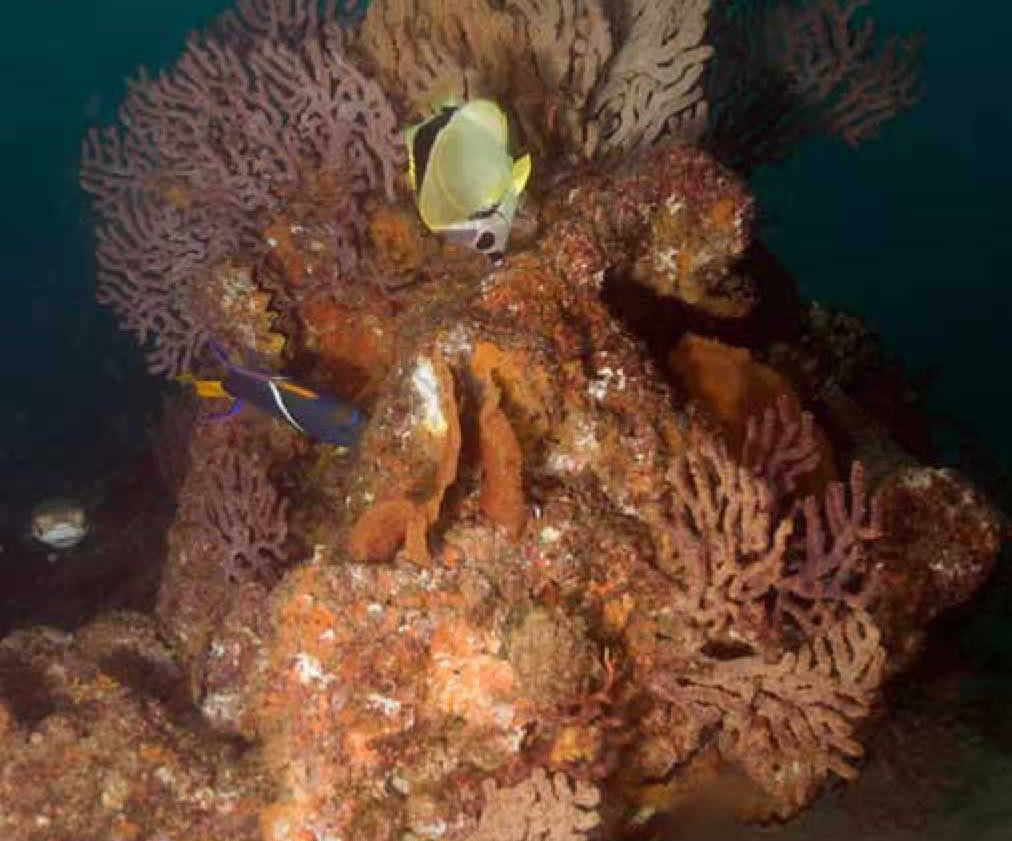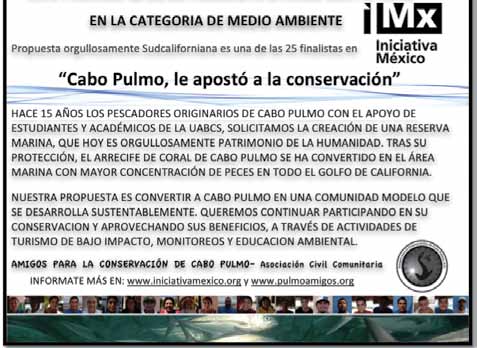 Cabo Pulmo is the most important coral reef In the Gulf of California.
Cabo Pulmo is the most important coral reef In the Gulf of California.
(Photo: Ernesto Bolado Martínez)
“Is Paulina Godoy here?” asks a television journalist, accompanied by a cameraman and a group of curious boys and girls. “The Iniciativa México has sent you this letter,” he says after greeting a woman working at a rustic table.
Reading the letter, Paulina Godoy Aguilar learns that a sustainable development proposal for Cabo Pulmo is among the finalists in Iniciativa Mexico, organized by a big television network to award and publicize social and ecological projects.
”It's a proposal from the community,” says Godoy on behalf of the Friends for Conservation of Cabo Pulmo.
Meanwhile, Mario Castro Lucero, life-long fisherman and currently a tourist guide, takes the spotlight to point out that his group seeks training for the next generation, financing to continue cleaning the beaches, and support for the small businesses created as a result of the growing tourist trade. But more than anything, the activists want support to preserve the area.
Cabo Pulmo is a village of 150 residents located in Baja California Sur, about 120 miles southeast of the state capitol La Paz and about 30 miles north of the international resorts of Los Cabos. It has become a desirable destination for both tourists and scientists because of its coastal scenery and rich marine life.
It has the biggest population of corals in the Gulf of California, described by the legendary explorer Jacques-Yves Cousteau as “the aquarium of the world.”
The reefs of Cabo Pulmo are also home to a species of giant grouper, Epinephelus quinquefasciatus, classified as “endangered” by the International Union for the Conservation of Nature.
According to the National Commission for the Knowledge and Use of Biodiversity (Conabio), Cabo Pulmo is “a unique site where in a single day of diving one can see more fish species and top predators than in weeks of diving elsewhere, and where the bass and snapper breeding populations flourish year after year.
The locals were succesful in having the reef designated as a National Marine Park in 1995 in order to protect 18,000 acres, 99% of which includes marine zones. The same fisherman who fought for the preserve promised to stop all fishing or commercial activities in the park. The prohibition of businesses and public or private projects that alter the area's natural state makes Cabo Pulmo a model for sustainable management of marine parks.
 Cabo Pulmo is the most important coral reef In the Gulf of California.
Cabo Pulmo is the most important coral reef In the Gulf of California.
(Photo: Ernesto Bolado Martínez)
 The proposal submitted by Friends for the Conservation of Cabo Pulmo was one of 25 finalists in Iniciativa México (Mexico Initiative), a nationwide call for proposals being launched during the 2010 bicentennial year. It hopes to revive a Mexico that is dynamic and entrepreneurial” as well as to “recognize the efforts of people who, through their proposed projects, work for the Mexico that everyone holds dear.” The non-profit group proposes community development that is sustainable and protects the natural resources of the Park for future generations.
The proposal submitted by Friends for the Conservation of Cabo Pulmo was one of 25 finalists in Iniciativa México (Mexico Initiative), a nationwide call for proposals being launched during the 2010 bicentennial year. It hopes to revive a Mexico that is dynamic and entrepreneurial” as well as to “recognize the efforts of people who, through their proposed projects, work for the Mexico that everyone holds dear.” The non-profit group proposes community development that is sustainable and protects the natural resources of the Park for future generations.
Conservation Struggle
Begins
to Bear Fruit
The residents are trying to defend the area with the proposal they sent to Iniciativa México, by collecting signatures against the mega-development, and by environmental education campaigns and conservation programs.
They have gained support of environmental organizations worldwide. Furthermore, to date, they have presented three appeals for revision and two writs seeking constitutional protection that will have to be considered by the authorities.
In its publicity campaign Hansa, a Spanish company, promises to be a “good neighbor,” claiming that Cabo Cortés will become a “planned, integrated tourist community” of 10,000 acres.
But Greenpeace Spain says Hansa hasn't complied with Mexican environmental legislation. It accused the consortium of, among other things, “causing a grave impact on the Spanish coastlines [and] seeking to export that same model that not only consumes huge quantities of natural resources but also tries to do it outside of the law.”
Certainly, Cabo Pulmo isn't an isolated case regarding the sale of natural resources. It's already quite fashionable all over the country especially in the Gulf region, and, as such, it inspires the creation of environmental groups to defend the territory.